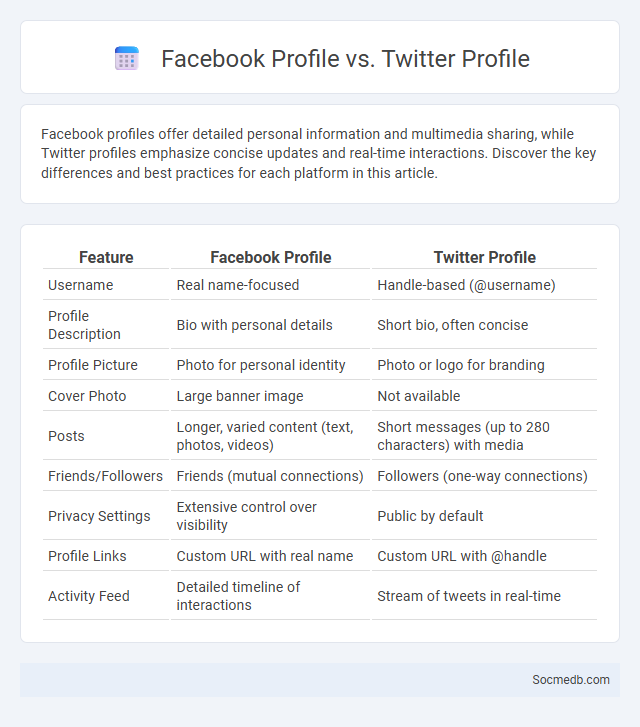
Photo illustration: Facebook Profile vs Twitter Profile
Facebook profiles offer detailed personal information and multimedia sharing, while Twitter profiles emphasize concise updates and real-time interactions. Discover the key differences and best practices for each platform in this article.
Table of Comparison
| Feature | Facebook Profile | Twitter Profile |
|---|---|---|
| Username | Real name-focused | Handle-based (@username) |
| Profile Description | Bio with personal details | Short bio, often concise |
| Profile Picture | Photo for personal identity | Photo or logo for branding |
| Cover Photo | Large banner image | Not available |
| Posts | Longer, varied content (text, photos, videos) | Short messages (up to 280 characters) with media |
| Friends/Followers | Friends (mutual connections) | Followers (one-way connections) |
| Privacy Settings | Extensive control over visibility | Public by default |
| Profile Links | Custom URL with real name | Custom URL with @handle |
| Activity Feed | Detailed timeline of interactions | Stream of tweets in real-time |
Introduction to Social Media Profiles
Social media profiles serve as digital representations of individuals or brands, showcasing personal information, interests, and online activity. Well-crafted profiles enhance visibility, foster engagement, and build credibility across platforms like Facebook, Instagram, and LinkedIn. Key elements include profile images, bios, contact information, and customized links to optimize audience connection and interaction.
Overview of Facebook Profiles
Facebook profiles serve as your personal hub on the platform, showcasing your photos, interests, and connections to friends and family. Profile customization options include updating your bio, profile picture, and cover photo to reflect your identity and interests accurately. Privacy settings allow you to control who views your information, ensuring your personal data and shared content remain secure.
Key Features of Twitter Profiles
Twitter profiles feature a customizable bio section where users can highlight personal or professional information in up to 160 characters, enhancing identity and brand presence. The profiles also display a header image and profile picture, creating a visually distinct space that supports user recognition and engagement. Key metrics such as follower count, following count, and tweet count offer insights into a profile's reach and activity, which are critical for social media analytics and marketing strategies.
What Defines a General Profile?
A general profile on social media typically includes basic personal information such as name, age, location, and profile picture, designed to establish identity and facilitate connections. It often features a brief bio or description, interests, and links to other social platforms, enabling users to present a casual yet relatable online presence. Privacy settings and content shared within this profile define how much personal data is accessible, balancing openness with security across platforms like Facebook, Instagram, and Twitter.
Privacy Settings: Facebook vs Twitter
Facebook offers extensive privacy settings allowing users to control who can see posts, manage friend lists, and customize data sharing preferences, enhancing Your control over personal information. Twitter's privacy options are more limited, primarily focusing on protecting tweets, managing direct message permissions, and blocking unwanted interactions. Comparing Facebook and Twitter privacy settings reveals Facebook's greater flexibility for users seeking granular control over their social media presence.
Customization and Personalization Options
Social media platforms offer extensive customization and personalization options to enhance Your user experience by tailoring content feeds, notifications, and privacy settings to individual preferences. Advanced algorithms analyze Your interactions to suggest relevant posts, groups, and advertisements that align with Your interests and behavior patterns. Customizable profile themes, avatars, and display settings allow users to create unique online identities reflecting their personality and style.
Content Sharing Capabilities
Social media platforms enhance your content sharing capabilities by enabling instant distribution of images, videos, and text across vast networks. Features such as hashtags, tagging, and sharing buttons optimize visibility and engagement, boosting your message's reach organically. Leveraging user-generated content and real-time feedback fosters community interaction and strengthens brand presence.
Audience Interaction and Engagement
Maximizing audience interaction and engagement on social media requires creating compelling content that resonates with Your target demographic, encouraging meaningful comments and shares. Utilizing interactive features such as polls, live videos, and Q&A sessions fosters real-time connections and boosts visibility through platform algorithms. Monitoring analytics helps refine strategies to maintain active participation and strengthen Your online community.
Professional vs Personal Branding
Professional branding on social media emphasizes expertise, industry reputation, and career achievements, often showcased through platforms like LinkedIn. Personal branding highlights individuality, lifestyle, and values, commonly shared on Instagram or Facebook to build authentic connections. Balancing both strategies enhances credibility while fostering genuine engagement with diverse audiences.
Choosing the Right Profile for Your Needs
Selecting the right social media profile depends on understanding your target audience and the specific goals you want to achieve, such as personal branding, business marketing, or community engagement. Platforms like LinkedIn excel for professional networking and industry insights, while Instagram and TikTok offer visual appeal for creative expression and brand promotion. Tailoring your content and profile features to the unique strengths of each platform maximizes reach, engagement, and relevance in your niche.
 socmedb.com
socmedb.com